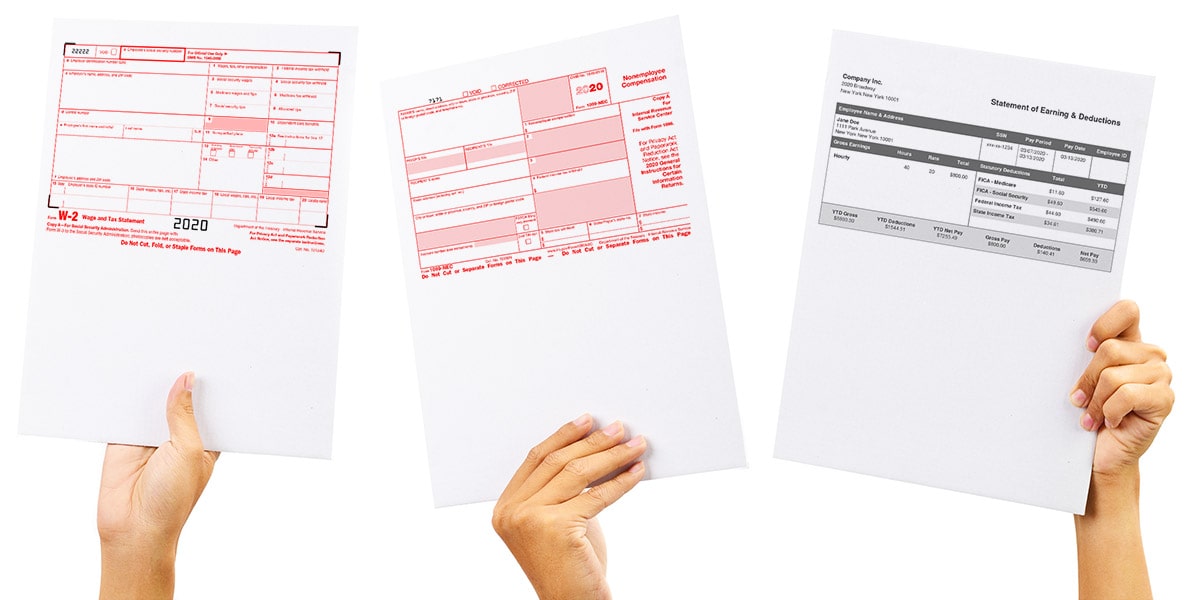A Basic Guide to Payroll Taxes

Payroll is the most complex task your business must complete. If you understand each step in the process- and use technology- completing payroll will take less time.
This article explains the differences between independent contractors and employees, and the key information you need to process payroll. You’ll review an example of calculating payroll, and the types of tax forms you must provide to your workers.
When you process payroll, independent contractors and employees are handled differently.
Independent Contractors vs. Employees
The IRS distinguishes independent contractors from employees by using three criteria:
- Behavioral control: Does the company have a right to control what the worker does and how they perform the job?
- Financial control: Does the company have a say in the material aspects of a worker’s job? In other words, does the business decide which expenses are reimbursed, or who provides the necessary tools and supplies?
- Contractual Relationship: Is there a written contract? Are benefits, such as pension, insurance, and vacation days, part of the contractual obligation?
FICA taxes are paid by workers and employers to fund Medicare and Social Security. When the three criteria above are met, the IRS considers the worker to be an employee of the company, and the firm is responsible for filling out a W-4 and paying a share of the FICA taxes.
If any of these criteria are not met, the worker is an independent contractor who is responsible for paying his or her own taxes, including income tax and FICA tax.
Employees must complete a W-4.
Working with Form W-4
The Employee’s Withholding Allowance Certificate (Form W-4) is a form that the federal government requires employees to fill out when they are newly hired. Information submitted on the form (allowances) lets employers know how much salary to withhold from a paycheck for tax purposes.
Keep these points in mind:
- As an employer, you should keep an employee’s most current W-4 form in his or her payroll file. The IRS may request a copy of the form.
- You need to make sure that you add the correct number of allowances into your payroll processing system.
The W-4 collects the worker’s basic information (name, address, filing status) and provides guidance for employees who have multiple jobs, or who have working spouses. There are extra resources provided to calculate withholdings for these situations.
Before running payroll, you’ll also need to know the amount owed to independent contractors.
Information Needed to Process Payroll
Determine this information for each employee and independent contractor:
- Payroll cycle: The number of pay periods determines how much salary is paid on each payroll date. It also determines the start and ending days for computing hourly payroll. A contractor’s pay may also depend on hours worked.
- Wages: Gross pay and net pay. Wages may be based on a salary, or calculated using an hourly rate of pay.
- Tax withholdings: Federal, state, and possibly local amounts withheld for taxes. Typically, no taxes are withheld from a contractor’s pay.
- Benefit withholdings: Amounts withheld for the employee’s share of insurance premiums, or funds to be invested in a retirement plan. Benefits are not offered to contractors, in most cases.
Here’s a simple example to help you understand the payroll process.
Calculating Net Pay
Sally’s annual income is $60,000, and your firm processes payroll 26 times a year. Sally’s gross wages each pay period total ($60,000 / 26), or $2,308 per pay period.
Based on the allowances on her W-4, assume that your company should withhold 20% of her gross pay ($462) for federal taxes, and 5% ($115) for state taxes. Sally also pays $50 each pay period for her share of the company health insurance plan.
Sally’s net pay is $2,308, less a total of $577 for taxes, and $50 for her health insurance premiums. Her net pay is $1,681.
Most firms provide a pay stub to each worker, which includes all of this information for the current payroll period and year-to-date. The pay stubs you generate may also include unemployment tax payments. Hourly workers need detail on their total hours worked, and any hours that are paid as overtime wages.
Each year, your firm must provide a 1099-NEC to contractors, and a W-2 to employees.

Form 1099-NEC
Companies use Form 1099-NEC to report income earned by people who work as independent contractors, rather than employees.
The IRS requires businesses to mail a copy of Form 1099-NEC to the independent contractor, so the contractor can include the income in his or her tax calculation. The IRS also receives a copy of the 1099-NEC, and uses it to estimate how much tax revenue to expect from self-employed individuals.
Issuing a W-2 Form
In a similar way, employees are issued a W-2, which lists gross pay, and all tax withholdings for the year. Creating paystubs and tax forms is complicated, and you need the help of an expert
How FormPros Can Help
FormPros offers expertly customized business and tax forms. The software provides intuitive forms that ask the right questions, so you can quickly generate documents at a fraction of the cost of hiring a lawyer.
Your business can generate 1099-NEC documents, Form W-2, and W-9 forms using FormPros. The process is quick and painless, and you’ll have more time available to grow your business.